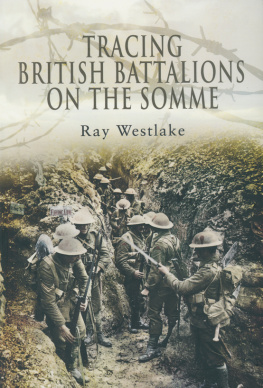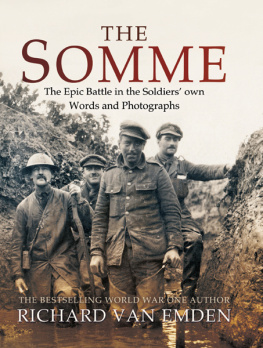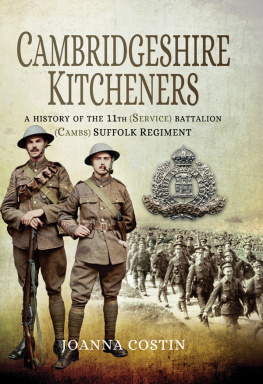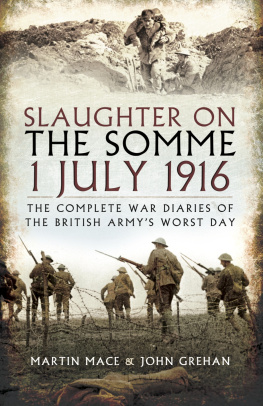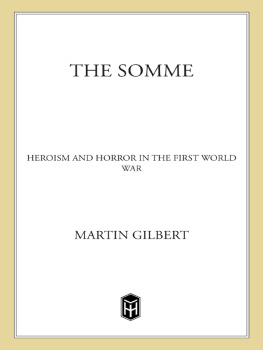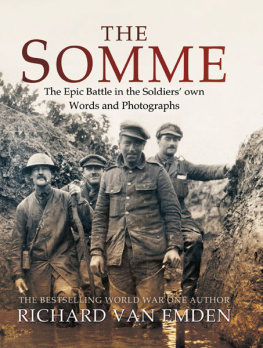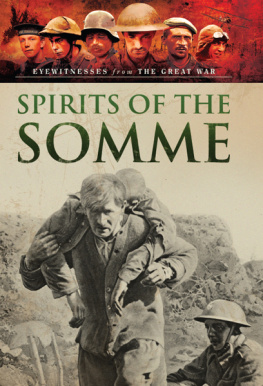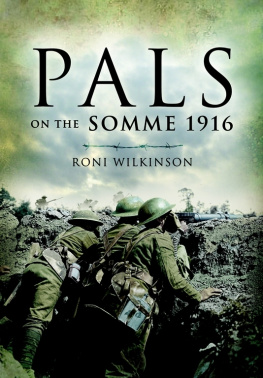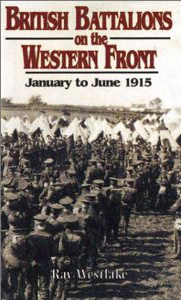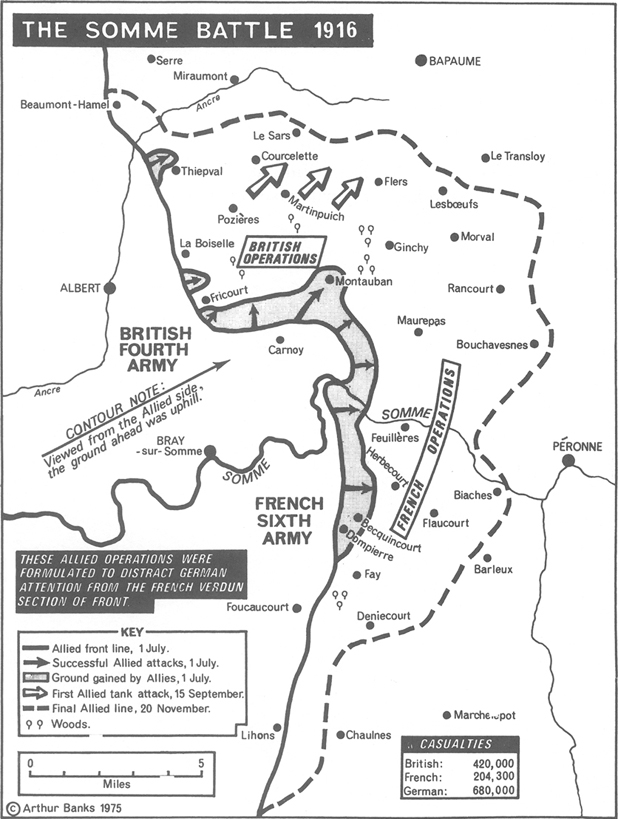TRACING
BRITISH BATTALIONS
ON THE SOMME
Other books by the same author
Collecting Metal Shoulder Titles
(Leo Cooper, 1980)
British Regiments at Gallipoli
(Leo Cooper, 1996)
British Battalions in France & Belgium 1914
(Leo Cooper, 1997)
TRACING
BRITISH BATTALIONS
ON THE SOMME
by
Ray Westlake
First published in Great Britain in 1994
Reprinted in 1995 and 1998 by Leo Cooper
Republished in 2004 by Pen & Sword Select
Republished in this format in 2009 and reprinted in 2011 by
Pen & Sword Military
An imprint of
Pen & Sword Books Ltd
47 Church Street
Barnsley
South Yorkshire
S70 2AS
Copyright Ray Westlake, 2004, 2009, 2011
ISBN 978 184415 885 0
The right of Ray Westlake to be identified as Author of this work has been asserted
by him in accordance with the Copyright, Designs and Patents Act 1988.
A CIP catalogue record for this book is
available from the British Library
All rights reserved. No part of this book may be reproduced or transmitted in any
form or by any means, electronic or mechanical including photocopying, recording
or by any information storage and retrieval system, without permission from the
Publisher in writing.
Printed and bound in England
By CPI UK
Pen & Sword Books Ltd incorporates the Imprints of Pen & Sword Aviation,
Pen & Sword Family History, Pen & Sword Maritime, Pen & Sword Military,
Wharncliffe Local History,
Pen & Sword Select, Pen & Sword Military Classics, Leo Cooper, Remember
When, Seaforth Publishing and Frontline Publishing
For a complete list of Pen & Sword titles please contact
PEN & SWORD BOOKS LIMITED
47 Church Street, Barnsley, South Yorkshire, S70 2AS, England
E-mail: enquiries@pen-and-sword.co.uk
Website: www.pen-and-sword.co.uk
for
Keith Enright
who hopefully will never know war.
Introduction
The idea behind this book evolved as a result of many years of enquiries from historians and researches. There has also been in recent times a welcome interest shown by many who simply wish to know where their relatives served during the Great War. I hope this work will provide help, at least as far as the 1916 Battle of the Somme is concerned, and literally enable any visitor to France to follow in the footsteps of their grandfathers, fathers, uncles, etc.
British Battalions of the Somme 1916 is not intended to be a history of the battle. Other and more knowledgeable authors having already covered this important period of British military history adequately. What has been provided is an account of some 616 infantry battalions belonging to regiments of the British Army and the 63rd (Royal Naval Division) during their service in the Somme area, battles and engagements, along with movements out of the line, being dealt with at battalion level rather than on a larger and less detailed divisional scale.
The period covered by this work is that generally accepted as The Battle of The Somme viz: 1 July18 November, 1916. Movements of battalions are generally dealt with while each remains within the area designated as Departement de la Somme. Consequently, locations out of the battle area, such as those around Amiens, Abbeville and Doullens appear in the records of each. Geographically, positions in the vicinity of the Gommecourt sector (Pas de Calais) would not qualify. However, the importance of this part of the line and the fighting that went on there necessitates their inclusion.
Normally, locations given are those where the majority of the battalion bivouacked or billeted. Often small parties (or single companies) moved away for temporary attachment to other formations, or on work detail, and this has been mentioned where known. Trench names are as given in war diaries. Casualty figures, where given, are generally those recorded in war diaries and are made up from killed, wounded and missing lists.
Notes on Infantry Organization
In 1914 infantry battalions of the British Army were those contained within the 4 regiments of foot guards (Welsh Guards raised Feb. 1915) and some 69 Line regiments. There were also several regiments made up entirely from members of the Territorial Force.
Each Line regiment contained Regular battalions (usually 2) and a number of Reserve battalions (the old Militia). In the case of English, Scottish and Welsh regiments, these also had Territorial Force battalions intended for home defence. At the outbreak of war Lord Kitchener created a New Army and these battalions were added and numbered on from those Regular, Reserve and Territorial battalions of Line regiments already in existence.
Regular battalions (usually numbered 1st and 2nd) are referred to by number only. In the main, Reserve battalions did not go overseas as such. Those that did are listed as (Extra Reserve). The titles of Territorial Force battalions are followed by the letters (T.F.), while those of Kitcheners New Army include the word (Service). A number of non-combatant battalions (Labour) were also raised and numbered within regiments.
A Division (in 1916) comprised 3 infantry brigades (each containing 4 battalions) and a pioneer battalion. In the case of the 9th (Scottish) Division, 1 brigade was made up entirely from South African battalions, while in the 29th the 88th Infantry Brigade included the Newfoundland Regiment.
Sources of Information
The main source of information for this book has been war diaries and unit histories. The latter amounts to some 250 volumes, making a list impractical. War diaries are held at the Public Records Office under W.O.95 classification. References drawn from published memoirs, diaries, etc, have been acknowledged in the text. My own files (RAY WESTLAKE UNIT ARCHIVES) have also been put to good use the 6,000-plus files formed over the last twenty-five years providing in many cases hitherto unpublished information.
The following works have been essential:
History of The Great War Order of Battle of Divisions, Major A.F. Becke.
Part 1 Regular British Divisions
Part 2A 1st Line Territorial Force Divisions
Part 2B 2nd Line Territorial Force Divisions
Part 3A New Army Divisions (9th26th)
Part 3B New Army Divisions (30th41st) and 63rd (R.N.)
H.M.S.O. 1935, 1936, 1937, 1938, 1945.
History of The Great War Military Operations France and Belgium 1916.
Two volumes, Brigadier-General Sir James E. Edmonds, Macmillan, 1932, 1938.
British Regiments 191418, Brigadier E.A. James. Samson Books 1978.
When The Barrage Lifts, G. Gliddon, Gliddon Books, 1987.
The V.C. and D.S.O, Sir OMoore Creagh, V.C. and Miss E.M. Humphris.
Standard Art Book Co. Ltd, 1924.
Monthly Army List, June, 1916, War Office.
Acknowledgements
The help given by the following individuals and organizations has made this book possible Major P.J. Ball (Duke of Edinburghs Royal Regiment Museum), Stuart Barr, Malcome Baxter, Mike Beckett, Bedfordshire Records Office, Major M. Beedle, Christine Beresford (Regiments of Gloucestershire Museum), John Bodsworth, Dr Stephen Bull, Canterbury City Council, Major J. Carroll (Dorset Military Museum), Terry Carter, Ann Clayton, Gillian Cooke (Thameside Local Studies Library), Colonel J.S. Cowley (Kings Own Yorkshire Light Infantry Museum), Geoffrey Crump (Cheshire Regiment Museum Researcher), Brigadier J.M. Cubiss (The Prince of Waless Own Regiment of Yorkshire Museum), Colonel C.D. Darroch (Royal Hampshire Regiment Museum), Pete Duckers, Stuart Eastwood, Lieutenant-Colonel Clive Elderton, Billy Ervine (Somme Association), Charles Fair, Nick Forder, Bob Gregory, Captain C. Harrison (Gordon Highlanders Museum), Hertfordshire Records Office, Norman Holme (Royal Welch Fusiliers Museum), I. Hook (Essex Regiment Museum), Les Hughes, Jim Kellerher, Peter Lead, Leicestershire Records Office, Lincolnshire County Council, Major R.D.W. McLean (Staffordshire Regiment Museum), Major C.D. Miller (Duke of Wellingtons Regiment Museum), Laurie Milner, National Museums and Galleries on Merseyside, Fred Perry, Earnie Platt, Public Records Office, Queens Lancashire Regiment Museum, Queens Own Highlanders Museum, R.A. Rayner, Paul Reed, Lieutenant-Colonel D.R. Roberts (Devonshire and Dorset Regiment Museum), Royal Scots Museum, Royal Sussex Regiment Museum, Royal Warwickshire Regiment Museum, Stephen Shannon (Durham Light Infantry Museum), South Wales Borderers Museum, Alan Stansfield, Margaret Stansfield, Graham Stewart, Suffolk Regiment Museum, Sussex Combined Services Museum, Welch Regiment Museum, Lieutenant-Colonel L. Wilson, John Woodroff.
Next page
